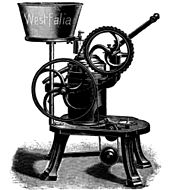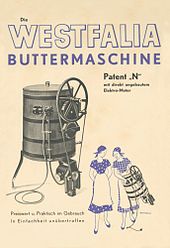GEA Westfalia Separator
| GEA Westfalia Separator Group GmbH
|
|
|---|---|
| legal form | GmbH |
| founding | September 1893 |
| Seat |
Oelde , Germany |
| Number of employees | around 3,500 worldwide |
| Branch | mechanical engineering |
| Website | www.westfalia-separator.com |
The GEA Westfalia Separator Group GmbH , headquartered in Oelde ( Westphalia ) is a German manufacturer of separators and decanters, which the GEA Group belongs. The company creates procedures and processes for the mechanical clarification and separation of liquids for the food industry, chemistry, pharmacy, biotechnology, energy, shipping and environmental technology.
history
- 1893-1900
On September 1, 1893, the brothers-in-law Franz Ramesohl and Franz Schmidt opened a workshop under the name Ramesohl & Schmidt oHG in Oelde . With five employees, two lathe operators and three fitters, they started the production of milk separators, which initially cost between 200 and 320 marks. In the year after the company was founded, the number of employees rose to 20 and the production rooms were expanded to include another building. In 1897 the annual production was 2,000 centrifuges , with 60 employees.
The company was converted into a stock corporation in 1899 by means of a partnership agreement. The share capital was 1,000 shares at 1,000 marks each and the turnover was 501,068 marks. In 1900, around 10,000 milk centrifuges from Ramesohl & Schmidt AG were already in use.
- 1901-1910
In 1901 the production of motorcycles was started and stopped again after a short time in the same year. In 1906, the company started manufacturing automobiles with 110 employees . In 1907 the first separator was used for the separation of mineral oil-water mixtures. One vehicle that has been preserved was on the list of participants for the Classic Days Schloss Dyck in 2018 .
- 1911-1920
The tough competition forced the company, despite initially promising figures, to stop production of Westfalia motor vehicles in 1913. In 1915 Werner Habig was appointed director and board member. In the same year, the three board members Richard Riefenberg, August Strothmann and founding member Franz Ramesohl resigned from their offices and Werner Habig joined the company. He managed Westfalia Separator until 1971.
- 1921-1930
In 1926 production was expanded to include bucket milking machines. The first mobile milking system for pasture operations was presented to the public at the agricultural exhibition in Dortmund in 1927. In 1929, the company founded Westfalia Separator Inc., the first company in the USA.
- 1931-1940
In 1931 the company presented the first self-cleaning separator. Co-founder Franz Schmidt died on March 18, 1937. In 1940, sales exceeded the 10 million Reichsmark (RM) mark for the first time .
- 1941-1950
The Ramesohl & Schmidt AG was on 29 September 1941 Westfalia Separator AG renamed. In the same year Westfalia Separator constructed the first continuously operating buttermaking machine. In the war years, production actually came to a standstill and sales fell to a low of almost 2.5 million RM at the end of the war. Reconstruction began in 1946 and as far as materials were available, a wide variety of in-house constructions were designed and manufactured, including spin dryers, circular saws, lamps, sleds, candlesticks, scooters, cloakrooms, toys and typewriters for the blind.
- 1950-1960
In the following years, separators as well as milking and feeding systems were developed and produced again. Westfalia Separator advanced to become the market leader in Germany. As early as 1954, the company exported its products to 70 countries. The first decanter was built in 1955.
- 1961-1970
In 1962, after only a year of construction, the Niederahr branch went into operation. In 1963, the Château-Thierry branch in France followed . In 1965 the manufacture of hand-operated separators was discontinued. In 1966, the employee magazine The Drum was published for the first time , and has been published six times a year since then. In 1967, Westfalia Separator's sales exceeded the DM 100 million mark for the first time , with the greater part of sales being generated through exports. In 1968 the product range includes 70 different separator models in 350 different designs.
- 1971-1980
In 1971 Werner Habig asked the supervisory board to release him from his duties as a board member; his successor was Otto Müller-Habig. Werner Habig became chairman of the supervisory board, replacing his brother Leo Habig. In 1973 sales exceeded the DM 200 million mark and the export share rose to 59 percent.
- 1981-1990
In 1987 the company was divided into the divisions Westfalia Separator Landtechnik and Westfalia Separator Trenntechnik in order to ensure more transparency and to delimit responsibilities more clearly. In 1988, the company introduced the Miele milking technology program as a second product line in the agricultural technology segment. Westfalia Separator AG achieved its highest turnover to date in 1989 with 530 million DM. The number of employees rose to over 3,000 for the first time. At this point in time, there were 23 subsidiaries abroad. By 1990 the company had received 450 patents, 210 of which were independent inventions. Internationally, more than 1,000 patents have been registered by 1990.
- 1990-2000
Westfalia Separator has been part of the GEA Group (based in Düsseldorf) since 1994 . The agricultural engineering division was spun off in 1996 and became an independent company called GEA Farm Technologies .
- Since 2000
In 2004 the association Nothilfe Westfalia Separator eV was founded, which advocates unbureaucratic help for employees in need as well as social projects in Oelde. In 2007 the authorized workshop was established in Tianjin in order to be able to serve the Chinese market even better. On February 13, 2008, the corporate form of Westfalia Separator AG was changed, the company has been operating as GEA Westfalia Separator GmbH since then .
Since January 1, 2010, GEA Westfalia Separator has been part of the GEA Group Segment GEA Mechanical Equipment .
Production locations and company structure
-
Oelde , Germany

-
Niederahr , Germany

-
Château-Thierry , France

-
Bengaluru , India

-
Wuqing , People's Republic of China

The GEA Westfalia Separator Group comprises more than 50 sales and service companies around the world. It is part of the GEA Group Segment GEA Mechanical Equipment and is divided into four business areas and subordinate business lines .
literature
- Manfred Kersten: Innovation based on tradition - 115 years of Westfalia Separator AG Oelde.
Web links
- Early documents and newspaper articles on GEA Westfalia Separator in the 20th century press kit of the ZBW - Leibniz Information Center for Economics .
Individual evidence
- ↑ List of participants for the Classic Days Schloss Dyck 2018 (PDF; accessed on August 12, 2018)
Coordinates: 51 ° 49 ′ 47.3 " N , 8 ° 7 ′ 58.2" E





